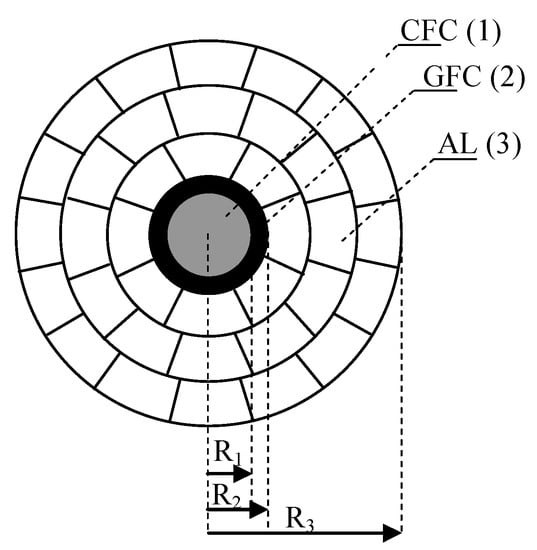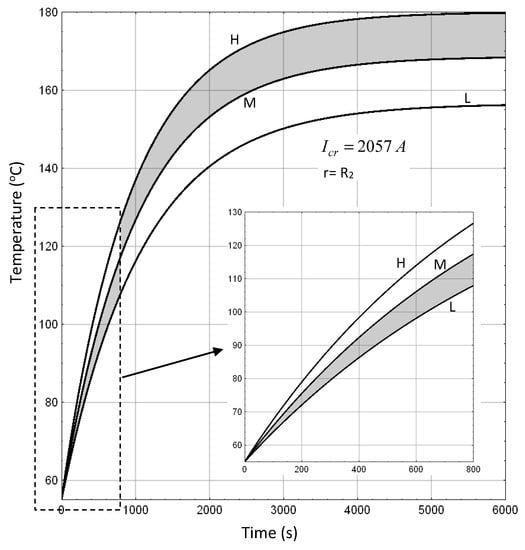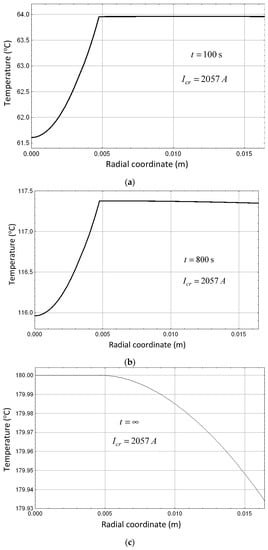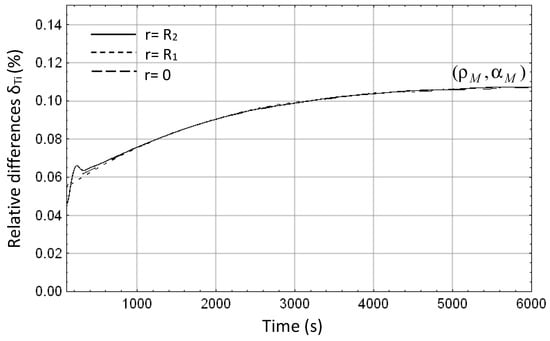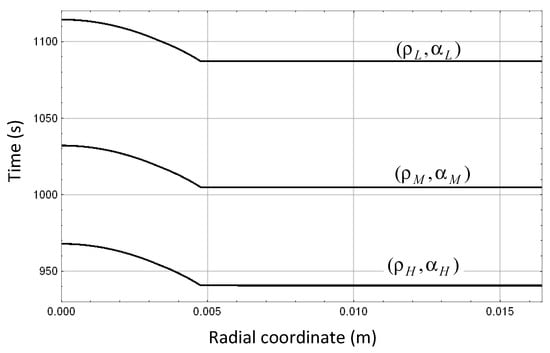Abstract
The paper investigates the dynamics of the thermal field of the ACCC (aluminum conductor composite core) line. The system was heated by solar radiation and current flow. Conductor cooling was modeled using the total heat transfer coefficient as the sum of convective and radiative components. The temperature increase generated by the current is described by a system of parabolic differential equations with an appropriate set of boundary, initial and continuity condition. The mentioned boundary-initial problem was solved by a modified Green’s method, adapted to the layered structure of the system. For this purpose, Green’s functions, as the kernels of integral operators inverse to differential ones, were determined. Aluminum resistivity and heat transfer coefficient change significantly with temperature. For this reason, the solution to the problem is presented in the form of a lower and upper estimation of the heating curve and local time constant. A steady-state current rating was also determined. The results are presented graphically and verified by other methods (power balance and finite element). The physical interpretation of the presented solution is also given.
1. Introduction
Power lines produced in the ACCC (aluminum conductor composite core) technology have a number of advantages over the classic ACSR (aluminum conductor steel reinforced) conductors. First of all, composite cores are 70% lighter and twice as strong [1] as steel ones. A core braid is made of fully annealed 99.7% aluminum (type 1350-O) [2]. Of all alloys of this metal, the resistivity of 1350-O aluminum is the lowest. In order to increase the effective cross section of aluminum (with the same diameter of the conductor) profiled trapezoidal strands are used. The above mentioned solutions lead to a significant reduction in the resistance of ACCC conductors and thus to a reduction in power loss (by 25–30%) compared to ACSR systems. Moreover, composite cores can operate at much higher temperatures than steel ones (180 °C and 85 °C, respectively) [2]. This results in a double increase in transmitted power. There is no need to change the diameter of the conductor or to strengthen/raise towers. In addition, composite cores have a very low coefficient of thermal expansion (). Combined with the low core weight, this results in low sag of ACCC conductors. In this way, a safe clearance between the line and objects below is maintained. In addition, covering the core and surface of the ACCC conductor with additional coatings significantly reduces thermal aging and retains flexural strength [3,4,5].
The disadvantages of ACCC conductors are the high price and the requirement for accurate installation (especially tensioning must be in accordance with the manufacturer’s instructions). The full annealing of aluminum makes the surface soft and susceptible to damage. However, the advantages of ACCC conductors described earlier make them an object of interest of companies dealing with electrical power transmission and distribution. Evidence of this is the many thousands of kilometers of ACCC conductors installed worldwide after 2005. For this reason, research on ACCC lines meet the needs of modern power engineering and electrical engineering.
Each technology has its own limit parameters. If the composite core sustainedly heats up above the maximum operating temperature, its accelerated aging process will occur. It may be manifested by a decrease in the flexibility of the core [3,4]. On the other hand, too large thermal field gradients lead to internal mechanical stresses and thus to smaller or larger displacement of the strands. In extreme cases of very high temperature (generated, e.g., by short-circuit current), the strands delaminate to form a kind of “birdcage” on the section of the conductor. Therefore, thermal field analysis is an important part of checking the correctness of the line design and its optimization.
The stationary surface temperature of the ACCC conductor can be determined [6] by the CIGRE [7] or IEEE [8] methods. They rely on an iterative solution to heat balance equations with respect to temperature. An interesting variation [8] is the conductor replica method [9]. The finite element method (FEM) [10] is much stronger than [7,8,9]. Transient thermal field in the cross-section of the ACCC conductor was analyzed in [3,11] using commercial FEM software. In [3], however, the skin effect and solar radiation were omitted. In [11] additional carbon nanostructure coatings were considered. In the thermal field analysis of ACCC systems, methods previously used to study classic ACSR lines will also be effective. The following methods should be mentioned here: finite difference (FDM) [12,13], finite volume (FVM) [14,15] and equivalent thermal circuit (ETC) [16,17,18].
The experimental methods [6] are also worth mentioning. The method of measuring variable temperature in a cylindrical current-heated system is briefly described in [19] (chapter experimental verification). The calculations given in this paper can be experimentally verified in the same way.
It follows from the above that the thermal field of the ACCC conductor can be calculated numerically or analytically. The first method allows for taking into account material non-linearities and conveniently maps the heterogeneity of the ACCC cross-section. The mesh of the numerical method imposes, however, a finite number of degrees of freedom. In turn, the main advantage of analytical methods is the result in the form of formulas. It facilitates physical interpretation of phenomena and discussion of the impact of individual parameters. In addition, the analytical solution enables quick field estimation at any selected points in the area and moments of time. Due to greater accuracy, analytical results are benchmark values for the numerical solutions tested. For the above-mentioned reasons, the thermal field of the ACCC line is investigated in this paper using the Green’s function [20,21,22] (i.e., by the analytical method). The Green’s function remains an important field theory tool used, among others, in mechanics, electrical engineering and physics. This is confirmed by three extensive monographs [20,21,22] devoted to this subject and published in the current decade. To the best of the authors’ knowledge, the Green’s method has not been used in published works dedicated to ACCC systems.
From the application point of view, it is important to estimate the following parameters and operational characteristics of the ACCC line: steady-state current rating, heating curve and time constant. The first value ensures the core thermal security. In turn, the last two values are the basic parameters of thermal field dynamics (e.g., when switching the line on and off, changing the load current, short circuit, discontinuous running, etc.). As previously mentioned, the problems transient states in ACCC conductors are relatively rare topics of other publications. For this reason, this paper contributes to filling this gap.
2. Physical Model of the ACCC Line
The cross section of the investigated system is shown in Figure 1. The bearing element of the ACCC line is the central core with radius. The core is made of carbon fiber epoxy composite (CFC). The next layer with , radiuses, protects aluminum against corrosion from carbon fibers. The layer 2 material is a glass fiber epoxy composite (GFC). The additional task of GFC is to increase the strength and flexibility of the core. The last area (index 3) is the current conductor. The conductor is twisted from soft and annealed aluminum trapezoidal strands. This cross-section ensures large contact surfaces between individual strands and their tight arrangement in the annulus (Figure 1). For this reason, a monolithic conductor structure was assumed. Helical stranding of strands was also omitted. This last simplification was compensated by introducing the stranding factor [23] into the formula for volumetric power density. Additionally, it was assumed that the aluminum surface is moderately oxidized (i.e., emissivity ). The outer diameter of the conductor () is much smaller than its length and dimensions of surrounding objects. The latter are at ambient temperature
The thermal field is generated from the moment of switching on the current with the power frequency f and the root mean square current . Low frequency allows one to neglected dielectric losses in composites relative to Joule heat produced in aluminum. The influence of the air boundary layer around the line was also omitted. It means uniformly heat transfer by the surface . The last assumption together with the axisymmetric geometry of the system allows one to approximate the thermal field with the radial coordinate and time functions.
Solar radiation can be taken into account by the surface density of its power (W/m2) [7,8] or the temperature of the sun sensor [9,24]. The second method was chosen in this paper. The simplest sensor is a replica of the conductor [9,24] located next to the real system. It was assumed that means the temperature of the entire volume of the replica, heated by solar radiation. Therefore, is also the conductor temperature before turning on the power (i.e., for ). The replica is never charged with electricity—there is only solar input. For this reason, a constant value of the replica’s temperature is assumed (even after turning on the power supply of the real line). The increase is a measure of the intensity of solar radiation.
The system cooling was modeled using the total heat transfer coefficient . It is the sum of [25] convection and radiation coefficients. The first component includes, among others, wind speed [19]. The cross flow direction relative to the line was assumed. The second component depends, among others, on emissivity [25] (p. 10). For the lower and upper estimation of the heating curve, temperature-time profiles will be determined for the following parameters.
where the following nomenclature was used:
- —conductor surface temperature (or average),
- —average boundary layer temperature,
- —maximum operating temperature (or sustained maximum temperature),
—temperature coefficient of electric resistivity.
3. Mathematical Model of the Thermal Field in the ACCC Line
The temperature increases and are calculated relative to and generated, respectively, by current flow and solar radiation ( for CFC, for GFC, for Al). According to the Electric Power Research Institute—USA [24], these increases can be analyzed separately. After averaging the thermal and material parameters, the system is linear. From the superposition of increases it results that
where: is the spatial-temporal distribution of temperature in the -th zone. The temperature increase forced by current was defined by the following initial-boundary problem for the heat equation [22,25].
where: and is the diffusivity of the i-th zone, is the thermal conductivity of the i-th zone, is the specific heat of the i-th zone, is the density of the i-th zone and are the consecutive radiuses of the conductor zones (Figure 1). The efficiency of the spatial heat source in the aluminum annulus was determined based on [26].
where: , is the resistivity of the conductor, is the magnetic permeability of a vacuum, —stranding factor, —the frequency and is an imaginary unit, are modified Bessel functions of the first and second kind of the order of p (p = 0 or p = 1), respectively.
There are no heat sources in the core, therefore .
In the considered model it was assumed that the current flow heats the system from . The temperature increase generated by the current is calculated relative to . This results in zero initial conditions in all zones of the conductor
The outer surface of the conductor () gives up heat by convection and radiation. The mentioned transfer is described by Hankel’s boundary condition [25]
where is the total heat transfer coefficient.
The particular layers of the conductor are closely adherent to each other. Therefore, the conditions for continuity of temperature increase and heat flux are met at the boundaries of regions
Equations (4)–(8) form the boundary-initial problem of the transient increase of the temperature field.
4. Green’s Functions of the Mathematical Model of the Thermal Field in the ACCC Line
The boundary-initial problem (4)–(8) was solved by the Green’s method [20,21,22]. In this method, it is unnecessary to determine the particular solution [27] of the heterogeneous Equation (4) for i = 3. This is the advantage of the Green’s function method, which does not depend on the forcing function [22]. In addition, this method does not require a separate determination of the stationary and transient temperature field components for later superposition. The above reasons prompted the authors to choose the Green method. Details on the definition, physical interpretation and description of the boundary-initial problem of Green’s function are given in [22,27,28]. In the considered model, the current-related increase in temperature in the i-th zone can be represented by the following integral relationship [28].
where is given by the relation (5) (after conversion ), is the Green’s function in the i-th zone, are parameters related to the definition of the Green’s function. The condition for using (9) is knowledge of the Green’s functions . One way to determine them is to solve the auxiliary (homogeneous) problem using two methods: separation of variables [25,27] and Green’s function [22,27].
The homogenous auxiliary problem in relation to the function is defined as below:
where is any distribution of the initial condition in the source zone (i.e., the third).
The boundary-initial problem (10)–(13) was solved first by the separation of variables method [25,27]. According to the method, after separating time and location variables and rejecting the singular component for the following was obtained.
where: , and are dimensionless eigenvalues (rescaled separation constants) of the boundary-initial problem (10)–(13), ,,, and are the coefficients of eigenfunctions and are Bessel functions of the first and second kind of order k. Then using the continuity (12a,b) and boundary (11) conditions, equation of the eigenvalues of the problem (10)–(13) was determined and the number of coefficients was reduced. For this purpose, the relations (14)–(16) were substituted to (12a,b) and (11). This leads to a homogeneous system of five equations relative to unknown coefficients , , , and .
where: ,, and ,.
The system of Equations (17)–(21) has a non-trivial solution if its main determinant is zero
where:
The condition (22) is an equation of eigenvalues.
Using of Equations (17)–(21), one can also reduce the number of unknown coefficients. For this purpose, the first four Equations (17)–(20) were used. As a result , , and coefficients were made dependent on one . The coefficients determined in this way were substituted to (15) and (16) and, after appropriate reduction, the following was obtained.
where:
The form of Equation (14) remained unchanged.
It is also necessary to determine the unknown coefficient visible in the formulas (14), (23), (24). For this purpose initial conditions (13) were used. After substituting distributions (14), (23), (24) into (24) into (13) the following was obtained
Subsequently, the relation (27) was multiplied by and integrated in the range . Analogous operations were performed on expressions (28) and (29) (respectively multiplied by and and integrated in ranges and ). The relations obtained in this way were added to each other. Subsequently, the orthogonality condition of the radial coordinate eigenfunctions in cylindrical multi-zone systems (proven in [27]) was used
where —square of the norm (32).
After calculating the suitable integrals in (30), ordering and replacing , the coefficient was obtained
where:
Then the integration variable was changed in (31) (). The expression thus modified was substituted to (14), (23) and (24).
The auxiliary problem (10)–(13) was solved again by another method (i.e., using the Green’s function [22])
The coefficient is the integral (31) and occurs in (14), (23) and (24) with the replaced variable . This makes it possible to compare the relations (14), (23)and (24) with (33) for i = 1, 2, 3 (including conversion ), respectively. As a result, the following was obtained.
where is the square of the norm (32). Green’s functions (34)–(36) are kernels of integral operators (9) inverse to differential ones (4).
5. The Time-and-Space-Variable Heating Curves, Steady State Current Ratings and the Time Constants
The time-and-space-variable heating curves were obtained after substitution of (34)–(36)–(9), integration and use of relationship (3).
where:
and is given by relation (5) (after conversion ). The integral (40c) is calculated numerically.
The temperature distributions (37)–(39) and other parameters of the ACCC conductor were calculated using a software developed in the Mathematica 10.4 environment [29]. The following data [3,19,23,25] were adopted:
Resistivity and heat transfer coefficients were defined according to (1a–c) and calculated using [19,25] Equation (2).
One of the most important parameters of the current path is steady-state current rating . After loading the system with such current, the steady-state aluminum temperature () should be equal to (maximum operating temperature). According to the manufacturer’s guidelines [1,6] was adopted. This value ensures core security under the highest thermal load conditions (i.e., for parameters ,). Therefore, in order to determine the steady-state current rating, one should solve the following equation with respect to .
Equation (42) was iteratively solved using (39) and (41) and while loops in Mathematica 10.4 [29]. The result was . The calculated current value was verified by the steady-state power balance. For this purpose, the following theorem was used [9]: if in the convection and radiation terms, the ambient temperature is replaced by the solar temperature , then the solar radiation power can be zeroed in the balance.
where the following nomenclature was used:
- —stranding factor [23] (p. 116),
- —skin factor [23] (Figure 7.2),
- —length of conductor’s section,
| —convective component of the total heat transfer coefficient (67.33%) [19], |
| —conductor surface, |
| —Stefan-Boltzmann constant. |
From the relationship (43a) was obtained . Therefore, the relative difference between solution (42) and (43a) is approx. 0.63%, which was considered good enough accordance. The discussed difference results from the approximation of the AC resistance with the expression (43b).
On the basis (39), the heating curves , and were plotted with heavy lines, which were respectively marked with letters and (Figure 2). They correspond to the parameters , and . The load current is constant and is (). For real time-profile is initially close to and then gradually approaches to (window in Figure 2). For the sought temperature-time history it increases analogously from the curve to . Therefore, the gray area visible in Figure 2 shows the range of changes of the real heating curve .
At the moment the system parameters are very close to , and in and respectively to and . Figure 3a–c show radial temperature distributions and where i = 1, 2 and i = 3 Gradual equalization of the core temperature as a result of its heating is visible (, and ). Due to inequality , this process is relatively slow. On the other hand, a high value means that in the annulus the Biot number (Bi) is very low (). This Bi value justifies the almost uniform temperature distribution in aluminum at any given time [25], e.g., from Figure 3c it follows: . Since the outer layer is a source of heat, its temperature increases rapidly over time (for approx. , for approx. , and in steady state it reaches ).
Figure 3.
(a) Radial temperature distribution at the instant with the current load , (b) radial temperature distribution at the instant with the current load and (c) radial temperature distribution in the steady state () with the load current .
In order to verify the correctness of formulas (37)–(39), the boundary-initial problem (4)–(8) was solved again. This was done using the finite element method (FEM) [10]. The Green and FEM methods are completely different. In the second case, the commercial NISA software was used [30]. The discrepancy of the results was evaluated using the following relation
where is the temperature increase (above ) caused by the current flow calculated by the Green method, and is the same increase but determined by the finite element method. Figure 4 shows the relation (44) for parameters . As one can see , which was considered good enough accordance. For parameters and the relative differences (44) are of the same order as in Figure 4.
Figure 4.
Relative difference (44) of temperature increases determined by means of the Green’s and finite element methods for parameters.
The local time constant method consists in approximating the dynamics of each point of the field with the first order lag element. The step response of such an object is well known and equals
where i = 1, 2 and 3. From (45) it results [31,32,33]
Heating curves (37)–(39) were substituted to (46) and, after integration, the following was finally obtained
Graphs of functions (47)–(49) are shown in Figure 5. The inequality shows that at any point the heating curve with parameters increases the fastest, and with parameters the slowest. For this is confirmed by Figure 2. In turn, the inequality (for makes the temperature in the composite core (CFC + GFC) increase more slowly than in aluminum. The high speed of heat propagation in the metal means that in its whole volume the time constant does not change. The same conclusions were drawn in the analysis of Figure 3 based on inequality . The steady state arose as a result of a gradual transition from M to H curve in Figure 2. For this reason, the duration of the transient state was estimated between and . This result is also confirmed by Figure 2.
6. Final Remarks
The conclusions below follow from the presented analysis:
- The presented solution also included the worst case analysis (i.e., the highest thermal load). It will occur for parameters and defined by formulas (1c). Thus, the critical aluminum heating curve is presented in the diagram H in Figure 2.
- The solution in the form of estimation of the heating curve and ACCC line time constant results from the strong influence of temperature on aluminum resistivity (change by 44.5%) and on the total heat transfer coefficient (change by 15.6%). Sensitivity of other parameters to temperature was much lower.
- Since the current rating was calculated in a steady state, the value of this parameter was precisely determined (i.e., without estimation).
- Solution verification carried out by other methods than Green’s function gave a positive result (power balance (43), finite elements—Figure 4).
- The analysis included 25 terms of the series (37)–(39) and (47)–(49). The following characteristics and parameters were determined: heating curves (37)–(39) for three different values of heat transfer coefficient and resistivity, time constants (47)–(49) and spatial temperature distributions presented in Figure 3a–c. The calculations were made in the Mathematica 10.4 program within 50 min.
Author Contributions
The authors equally contributed to the preparation of each excerpt of the paper: 50%, J.G.; 50%, M.Z. All authors have read and agreed to the published version of the manuscript.
Funding
The paper was prepared at Bialystok University of Technology within a framework of the S/WE/2/2018 project funded by Ministry of Science and Higher Education, Poland.
Conflicts of Interest
The authors declare no conflict of interest.
References
- CTC Global Website. Available online: http://www.ctcglobal.com/products/accc-conductors (accessed on 3 January 2020).
- Hunt, J.R. Advanced Technology High-Temperature Conductors. In Electric Power Generation, Transmission and Distribution; Grigsby, L., Ed.; CRC Press: Boca Raton, FL, USA, 2012; Chapter 24. [Google Scholar]
- Hoffman, J.D. On Thermal Aging Prevention in Polymer Core Composite Conductor Rods. Ph.D. Dissertation, University of Denver, Denver, CO, USA, 2015. Available online: https://digitalcommons.du.edu/etd/1066 (accessed on 3 January 2020).
- Burks, B.; Armentrout, D.L.; Kumosa, M. Failure prediction analysis of an ACCC conductor subjected to thermal and mechanical stresses. IEEE Trans. Dielectr. Electr. Insul. 2010, 17, 588–596. [Google Scholar] [CrossRef]
- Hoffman, J.; Middleton, J.; Kumosa, M. Effect of a surface coating on flexural performance of thermally aged hybrid glass/carbon epoxy composite rods. Compos. Sci. Technol. 2015, 106, 141–148. [Google Scholar] [CrossRef]
- CTC Global Corporation. Engineering Transmission Lines with High Capacity Low Sag ACCC Conductors; CTC Global Corporation: Irvine, CA, USA, 2011; ISBN 978-0-615-57959-7. [Google Scholar]
- CIGRE Working Group B2.42. Guide for Thermal Rating Calculations of Overhead Lines; Technical Brochure 601; CIGRE: Paris, France, 2014. [Google Scholar]
- IEEE Std. 738-2012. IEEE Standard for Calculating the Current-Temperature Relationship of Bare Overhead Conductors; IEEE Standard Association: Piscataway Township, NJ, USA, 2013. [Google Scholar]
- Lawry, D.C.; Daconti, J.R. Overhead line thermal rating calculation based on conductor replica method. In Proceedings of the IEEE PES Transmission and Distribution Conference and Exposition (IEEE Cat. No. 03CH37495), Dallas, TX, USA, 7–12 September 2003; pp. 880–885. [Google Scholar]
- Nithiarasu, P.; Lewis, R.W.; Seetharamu, K.N. Fundamentals of the Finite Element Method for Heat and Mass Transfer; John Wiley and Sons: Paris, UK, 2016. [Google Scholar]
- Ranjith Kumar, V.S.N.; Kumar, S.; Pal, G.; Shah, T. High-ampacity overhead power lines with carbon nanostructure-epoxy composites. J. Eng. Mater. Technol. 2016, 138, 9. [Google Scholar] [CrossRef]
- Chavez, O.; Mendez, F. Conjugate heat transfer in a bimetallic conductor with variable electric resistivity. Appl. Therm. Eng. 2011, 31, 3420–3427. [Google Scholar] [CrossRef]
- Ozisik, M. Finite Difference Methods in Heat Transfer; CRC Press: Boca Raton, FL, USA, 1994. [Google Scholar]
- Alvarez Gomez, F.; Garcia de Maria, J.M.; Garcia Puertas, D.; Bairi, A.; Granizo Arrabe, R. Numerical study of the thermal behaviour of bare overhead conductors in electrical power lines. Recent Researches in Communications. Electrical and Computer Engineering. In Proceedings of the 10th WSEAS International Conference on Applications of Electrical Engineering (AEE’11), Madrid, Spain, 24–26 March 2011; pp. 149–153. [Google Scholar]
- Eymard, R.; Gallouet, T.R.; Herbin, R. The Finite Volume Method. In Handbook of Numerical Analysis; Ciarlet, P.G., Lions, J.L., Eds.; Elsevier: Amsterdam, The Netherlands, 2000; Volume VII, pp. 713–1018. [Google Scholar]
- Hu, J.; Xiong, X.; Chen, J.; Wang, W.; Wang, J. Transient temperature calculation and multi-parameter thermal protection of overhead transmission lines based on an equivalent thermal network. Energies 2019, 12, 67. [Google Scholar] [CrossRef]
- Save, Y.O.; Narayanan, H.; Patkar, S.B. Solution of partial differential equations by electrical analogy. J. Comput. Sci. 2011, 12, 18–30. [Google Scholar] [CrossRef]
- Piotrowska, E. The equivalent electrical model for the heat exchanger considering working medium. Przegląd Elektrotechniczny 2015, 91, 246–248. [Google Scholar] [CrossRef]
- Coneybeer, R.T.; Black, W.Z.; Bush, R.A. Steady-state and transient ampacity of bus bar. IEEE Trans. Power Deliv. 1994, 9, 1822–1829. [Google Scholar] [CrossRef]
- Duffy, D.G. Green’s Functions with Applications; CRC Press: Boca Raton, FL, USA, 2015. [Google Scholar]
- Greenberg, M.D. Applications of Green’s Functions in Science and Engineering; Dover Publications: Mineola, NY, USA, 2015. [Google Scholar]
- Cole, K.D.; Beck, J.V.; Haji-Sheikh, A.; Litkouhi, B. Heat Conduction Using Green’s Functions; CRC Press: Boca Raton, FL, USA, 2011. [Google Scholar]
- Anders, G.J. Rating of Electric Power Cables: Ampacity Computations for Transmission, Distribution and Industrial Application; McGraw-Hill Professional: New York, NY, USA, 1997. [Google Scholar]
- Kubek, P.; Siwy, E. Analysis methods of HTLS conductors in terms of mechanical and thermal criteria. Acta Energ. 2013, 1, 75–82. [Google Scholar] [CrossRef]
- Incropera, F.; De Witt, D.; Bergman, T.; Lavine, A. Introduction to Heat Transfer; John Wiley and Sons: Hoboken, NJ, USA, 2007. [Google Scholar]
- Morgan, V.T. The current distribution, resistance and internal inductance of linear power system conductors - a review of explicit equations. IEEE Trans. Power Deliv. 2013, 38, 1252–1262. [Google Scholar] [CrossRef]
- Hahn, D.W.; Ozisik, M.N. Heat Conduction; John Wiley & Sons: Hoboken, NJ, USA, 2012. [Google Scholar]
- Haji-Sheikh, A.; Beck, J.V. Temperature solution in multi-dimensional multi-layer bodies. Int. J. Heat Mass Transf. 2002, 45, 1865–1877. [Google Scholar] [CrossRef]
- Wolfram Research Inc. Mathematica; Wolfram Research Inc.: Champaign, IL, USA, 2018. [Google Scholar]
- Manuals for NISA v.16; NISA Suite of FEA Software (CD-ROM); Cranes Software Inc.: Troy, MI, USA, 2008.
- Avramescu, A. Eindringzeit des elektromagnetischen Feldes und des Wärmefelds in Leiter. ETZ-A 1970, 91, 235–238. [Google Scholar]
- Brykalski, A. Über die Eindringzeit des elektromagnetischen Feldes in Leiter. Archiv Für Elektrotechnik 1985, 68, 299–304. [Google Scholar] [CrossRef]
- Gołębiowski, J.; Forenc, J. Parallel computations of the step response of a floor heater with the use of a graphics processing unit. Part 2: results and their evaluation. Bull. Pol. Acad. Sci. Tech. Sci. 2013, 61, 949–954. [Google Scholar] [CrossRef]
© 2020 by the authors. Licensee MDPI, Basel, Switzerland. This article is an open access article distributed under the terms and conditions of the Creative Commons Attribution (CC BY) license (http://creativecommons.org/licenses/by/4.0/).
